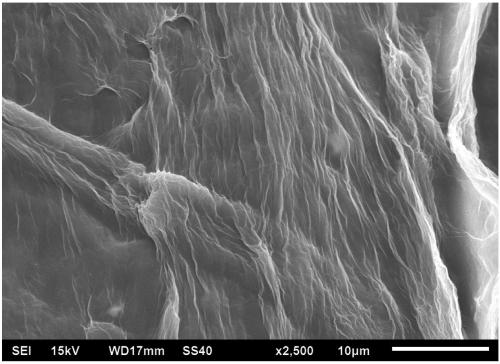Method for chemically modifying waterborne wood coating by using nano-cellulose dispersed graphene
A technology of nano-cellulose and dispersed graphite, which is applied in cellulose coatings, hemicellulose coatings, conductive coatings, etc., and can solve the problems of poor mechanical properties of water-based paint films and poor dispersion of nanoparticles
- Summary
- Abstract
- Description
- Claims
- Application Information
AI Technical Summary
Problems solved by technology
Method used
Image
Examples
specific Embodiment approach 1
[0053] Specific embodiment one: the method for present embodiment nano-cellulose disperses graphene chemically modified water-based wood coating, comprises the following steps:
[0054] One, the preparation of the nanocellulose aqueous liquid containing hemicellulose:
[0055] The cellulose raw material is sequentially subjected to extraction treatment and delignification treatment to obtain hemicellulose, and then mechanical pretreatment or chemical mechanical mixing pretreatment is performed to obtain hemicellulose-containing nanocellulose aqueous solution;
[0056] Described mechanical pretreatment, concrete operation steps are as follows:
[0057] ① Adding deionized water to the helium cellulose until the mass fraction of the helium cellulose is 0.1% to 0.3%;
[0058] ② Then use a 600bar high-pressure homogeneous mechanical treatment for 30-40 minutes to obtain a nano-cellulose aqueous dispersion containing hemicellulose, wherein the hemicellulose accounts for 20%-30% of ...
specific Embodiment approach 2
[0075] Specific embodiment two: the difference between this embodiment and specific embodiment one is: the specific steps of the extraction process described in step one are:
[0076] Crush the cellulose raw material into 90-120-mesh powder, and then carry out extraction treatment with benzyl alcohol for 10-12 hours; the benzyl alcohol is a mixture of toluene and absolute ethanol in a volume ratio of 2:1. Others are the same as in the first embodiment.
specific Embodiment approach 3
[0077] Specific embodiment three: the difference between this embodiment and specific embodiment one is: the specific steps of delignification treatment described in step one are:
[0078] ① Immerse the extracted cellulose powder in a sodium chlorite solution with a mass concentration of 1% to 1.2%, adjust the pH value of the solution to 4 to 5 with glacial acetic acid, and then magnetically place it in a constant temperature water bath at 75 to 80°C. Heat and stir for 1 to 1.5 hours;
[0079] ②Immerse the cellulose powder obtained in step ① into a sodium chlorite solution with a mass concentration of 1% to 1.2%, adjust the pH value of the solution to 4 to 5 with glacial acetic acid, and then magnetically heat it in a constant temperature water bath at 75 to 80°C Stir for 1~1.5h;
[0080] ③ Repeat step ② for 5-6 times to basically remove the lignin, then filter and wash the obtained liquid with a Buchner funnel until the filtrate is neutral, and finally obtain hedophilic cell...
PUM
| Property | Measurement | Unit |
|---|---|---|
| viscosity | aaaaa | aaaaa |
| particle size | aaaaa | aaaaa |
| tensile strength | aaaaa | aaaaa |
Abstract
Description
Claims
Application Information
 Login to View More
Login to View More - R&D
- Intellectual Property
- Life Sciences
- Materials
- Tech Scout
- Unparalleled Data Quality
- Higher Quality Content
- 60% Fewer Hallucinations
Browse by: Latest US Patents, China's latest patents, Technical Efficacy Thesaurus, Application Domain, Technology Topic, Popular Technical Reports.
© 2025 PatSnap. All rights reserved.Legal|Privacy policy|Modern Slavery Act Transparency Statement|Sitemap|About US| Contact US: help@patsnap.com



